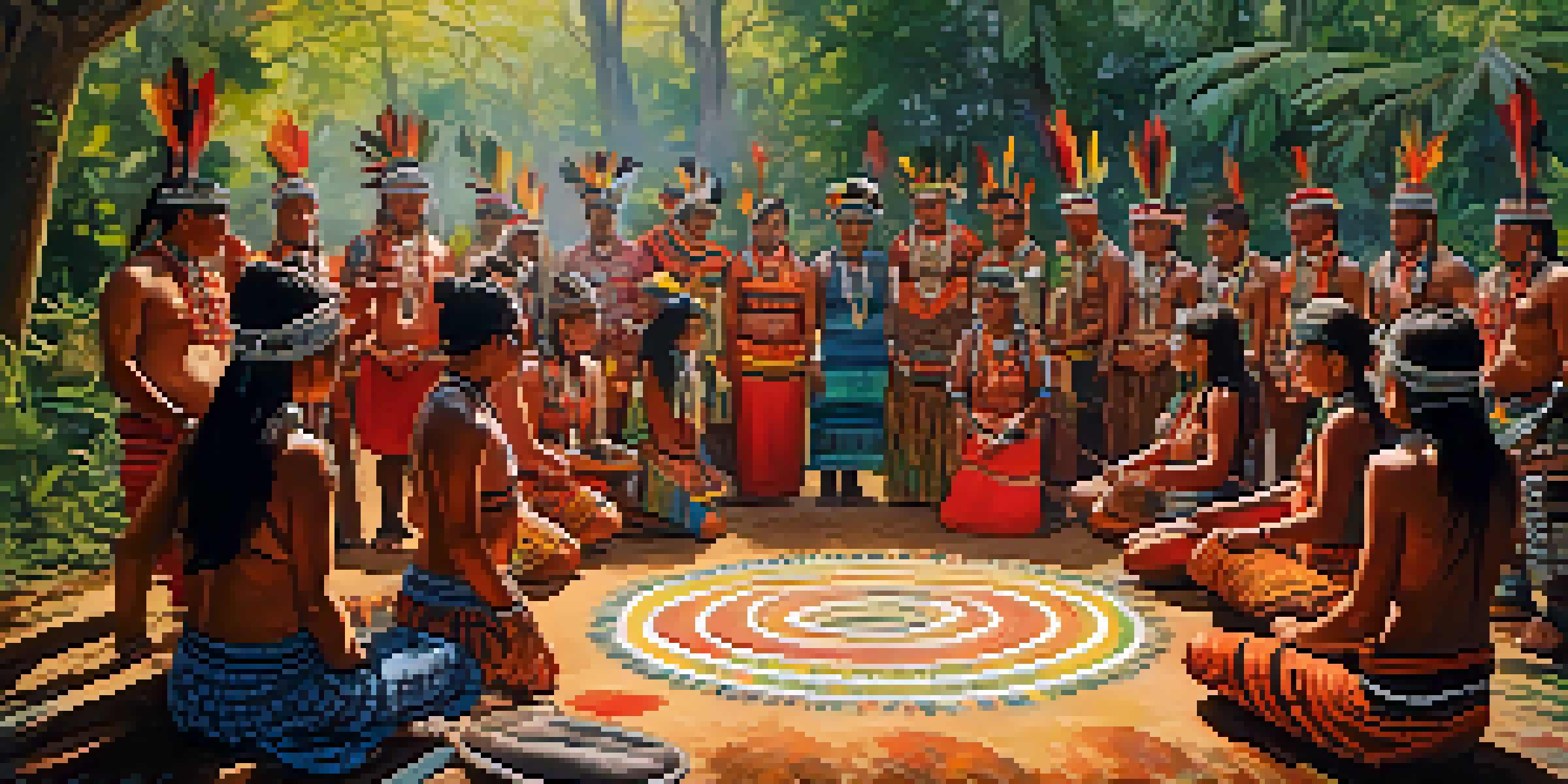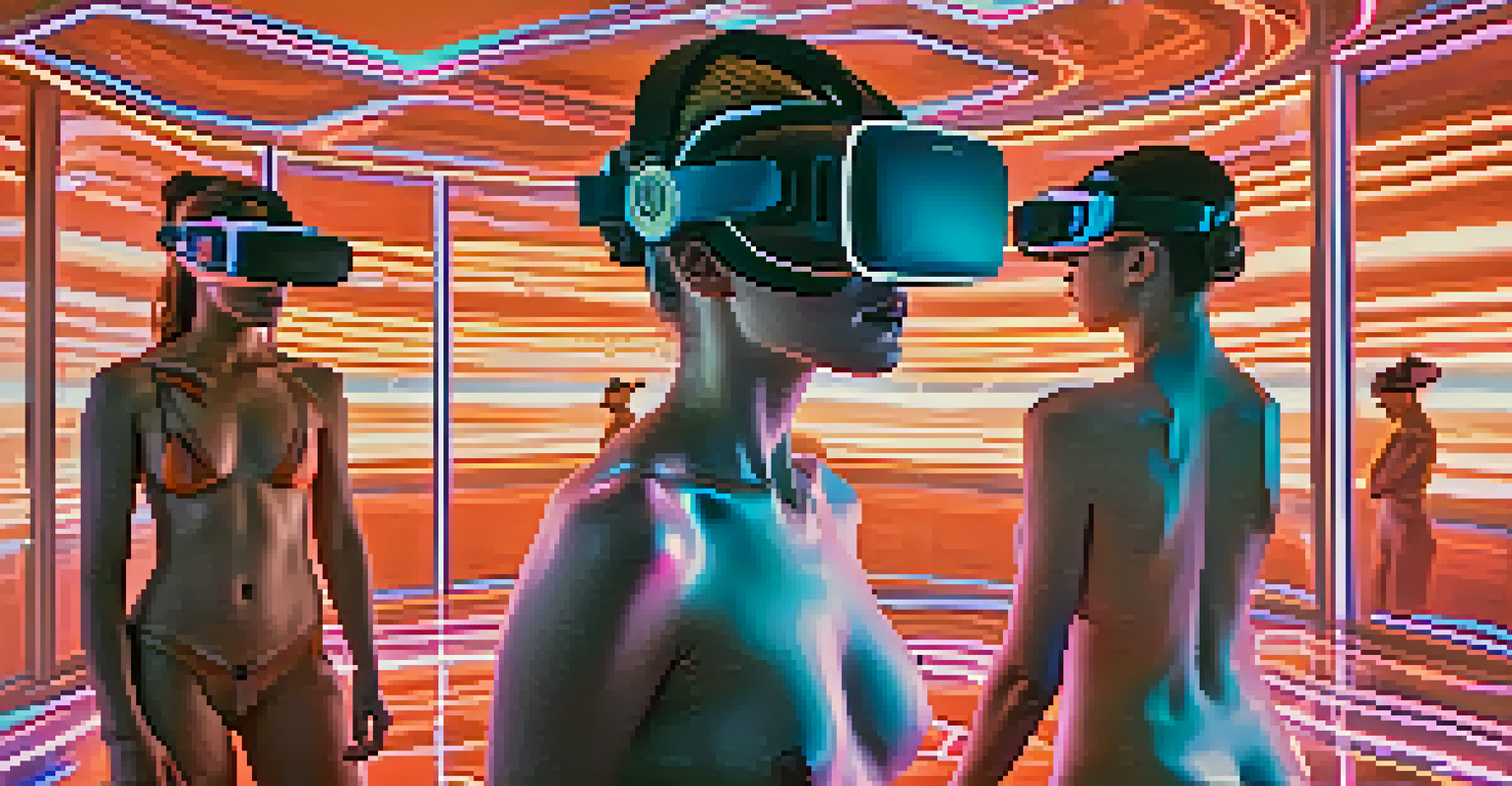The Evolution of Body Painting: A Cultural Journey Through Time

The Origins of Body Painting in Ancient Cultures
Body painting has roots that trace back to ancient human societies, where it served both decorative and functional purposes. Early humans used natural pigments, such as ochre, to adorn their bodies, often for rituals or to signify status within their tribes. These practices were not merely about aesthetics; they conveyed deep cultural meanings and beliefs, linking the physical body to the spiritual world.
Body painting is a way to express oneself, to tell a story that words cannot.
In many Indigenous cultures, body painting was integral to ceremonies, marking significant life events such as rites of passage or celebrations. For example, Native American tribes often used body paint to connect with ancestral spirits, while African tribes incorporated intricate designs to symbolize community identity and personal achievements. Each stroke of paint told a story, enriching the cultural tapestry of the time.
As we explore these ancient practices, we notice that body painting was a universal language. It transcended geographical boundaries, bringing together diverse cultures through shared expressions of art and identity. This early form of self-expression laid the groundwork for the evolving significance of body painting through the centuries.
Body Painting in the Context of Ritual and Spirituality
Throughout history, body painting has often intersected with spiritual beliefs and rituals. Many cultures viewed the body as a canvas for expressing devotion, protection, or transformation. For instance, in Hindu traditions, body art like mehndi is not just decorative but is believed to bring good fortune and blessings during weddings and festivals.

Similarly, in various African tribes, body paint is used in ceremonial dances to invoke ancestral spirits or to celebrate important communal events. The patterns and colors chosen often hold specific meanings, reflecting the tribe's history and values. These rituals highlight the profound connection between body art and community identity, fostering a sense of belonging and continuity.
Body Painting's Cultural Roots
Body painting has deep historical significance, serving as a form of self-expression and spiritual connection in ancient cultures.
This spiritual dimension of body painting emphasizes its role beyond mere aesthetics. It becomes a form of communication with the divine, reinforcing cultural narratives and collective memory. As we peel back the layers of these practices, we see how body painting serves as a bridge between the physical and spiritual realms.
The Transformation of Body Painting in the Renaissance
The Renaissance marked a significant shift in the approach to body painting, moving from ritualistic practices to artistic expression. Artists began to explore the human form, using body paint to enhance their works and depict the idealized beauty of the human body. This era celebrated individuality, leading to the emergence of body painting as a form of performance art.
Art is not what you see, but what you make others see.
Famous artists like Leonardo da Vinci and Michelangelo studied anatomy and proportion, influencing the way body paint was applied in their artworks. This period also saw the rise of theatrical performances, where actors would use body paint and costumes to portray characters vividly. Such practices highlighted the body as an expressive medium, showcasing both artistry and skill.
As body painting evolved during the Renaissance, it became intertwined with ideas of beauty and artistic innovation. It reflected a broader cultural shift towards humanism, emphasizing the importance of the individual and human experience, which would resonate in art and culture for centuries to come.
Modern Body Painting: Art Meets Self-Expression
In the 20th century, body painting underwent a remarkable transformation, emerging as a vibrant form of self-expression and contemporary art. Artists like Yves Klein and Andy Warhol experimented with body paint in their works, challenging traditional notions of art and the canvas. This shift not only elevated body painting to a respected art form but also encouraged personal expression.
Modern body painting often explores themes of identity, freedom, and societal norms. Events like body painting festivals and competitions allow artists to showcase their creativity while engaging with audiences in new ways. The act of painting the body becomes a celebration of individuality and a commentary on cultural issues, prompting conversations about beauty standards and representation.
Modern Trends in Body Painting
Today, body painting has evolved into a vibrant art form that explores themes of identity and societal norms while engaging audiences globally.
This evolution reflects a broader societal change towards acceptance and appreciation of diverse forms of expression. In today’s world, body painting can be seen as a powerful medium for storytelling, allowing artists and participants alike to reclaim their narratives and celebrate their identities.
Body Painting in Popular Culture and Media
As body painting has evolved, its presence in popular culture has grown significantly, influencing fashion, film, and even advertising. From iconic music videos to runway shows, body painting has captured the imagination of creators and audiences alike. This visibility has helped to elevate body painting as a legitimate art form, bridging the gap between traditional practices and contemporary expression.
One notable example is the use of body paint in film, where it enhances characters and creates immersive storytelling experiences. Movies like 'Avatar' showcased the use of body paint to build entire worlds and cultures, mesmerizing audiences and sparking conversations about creativity in film. This crossover has allowed body painting to reach new heights, attracting a diverse audience.
Moreover, social media platforms have played a crucial role in popularizing body painting, with artists sharing their work to global audiences. The accessibility of platforms like Instagram has helped to foster a community of body artists who inspire and challenge each other, creating a vibrant culture that celebrates innovation and artistic expression.
Cultural Sensitivity and Ethical Considerations in Body Painting
As body painting continues to flourish, it's essential to address cultural sensitivity and ethical considerations surrounding its practice. Many traditional body painting techniques are rooted in specific cultural and spiritual contexts, and appropriation can lead to misunderstandings and disrespect. Artists and participants must approach body painting with awareness and respect for its origins, ensuring that cultural elements are honored rather than exploited.
Engaging with communities and understanding the significance behind certain motifs or practices is crucial in fostering respectful artistic exchanges. Collaborations between artists and cultural custodians can create authentic representations that celebrate diversity while acknowledging historical contexts. This approach not only enriches the art but also promotes dialogue about cultural heritage and identity.
Ethical Practices in Body Art
Cultural sensitivity and ethical considerations are crucial in body painting, ensuring respect for traditional practices and fostering genuine artistic exchanges.
Ultimately, navigating these complexities requires a commitment to ethical practices and cultural appreciation. By prioritizing respectful engagement, the body painting community can thrive as a space for genuine expression, creativity, and mutual respect across cultures.
The Future of Body Painting: Trends and Innovations
Looking ahead, the future of body painting is poised for exciting developments, driven by technological innovations and shifting cultural landscapes. The rise of augmented reality (AR) and virtual reality (VR) opens up new possibilities for body painting, allowing artists to create immersive experiences that blur the lines between physical and digital art. Imagine stepping into a virtual gallery where body-painted models come to life in stunning detail!
Additionally, sustainability is becoming an essential consideration in the body painting community. Artists are increasingly using eco-friendly materials and techniques, aligning their practices with growing environmental awareness. This trend not only reflects a commitment to the planet but also resonates with audiences who value sustainable art forms.

As body painting continues to evolve, it remains a powerful medium for self-expression and cultural exploration. With each stroke and design, artists will undoubtedly push the boundaries of creativity, ensuring that body painting remains a dynamic and relevant art form in the years to come.